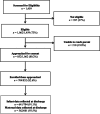Risk Factors for Postpartum Depression and Severe Distress among Mothers of Very Preterm Infants at NICU Discharge
- PMID: 37072014
- PMCID: PMC11223892
- DOI: 10.1055/s-0043-1768132
Risk Factors for Postpartum Depression and Severe Distress among Mothers of Very Preterm Infants at NICU Discharge
Abstract
Objective: To identify psychological, medical, and socioenvironmental risk factors for maternal postpartum depression (PPD) and severe psychological distress (SPD) at intensive care nursery discharge among mothers of very preterm infants.
Study design: We studied 562 self-identified mothers of 641 infants born <30 weeks who were enrolled in the Neonatal Neurobehavior and Outcomes in Very Preterm Infants Study (NOVI) conducted in nine university-affiliated intensive care nurseries. Enrollment interviews collected socioenvironmental data, depression, and anxiety diagnoses prior to and during the study pregnancy. Standardized medical record reviews ascertained prenatal substance use, maternal and neonatal medical complications. The Edinburgh Postnatal Depression Scale and Brief Symptom Inventory were administered at nursery discharge to screen for PPD and SPD symptoms, respectively.
Results: Unadjusted analyses indicated mothers with positive screens for depression (n = 76, 13.5%) or severe distress (n = 102, 18.1%) had more prevalent prepregnancy/prenatal depression/anxiety, and their infants were born at younger gestational ages, with more prevalent bronchopulmonary dysplasia, and discharge after 40 weeks postmenstrual age. In multivariable analyses, prior depression or anxiety was associated with positive screens for PPD (risk ratio [RR]: 1.6, 95% confidence interval [CI]: 1.1-2.2) and severe distress (RR: 1.6, 95% CI: 1.1-2.2). Mothers of male infants had more prevalent depression risk (RR: 1.7, 95% CI: 1.1-2.4), and prenatal marijuana use was associated with severe distress risk (RR: 1.9, 95% CI: 1.1-2.9). Socioenvironmental and obstetric adversities were not significant after accounting for prior depression/anxiety, marijuana use, and infant medical complications.
Conclusion: Among mothers of very preterm newborns, these multicenter findings extend others' previous work by identifying additional indicators of risk for PPD and SPD associated with a history of depression, anxiety, prenatal marijuana use, and severe neonatal illness. Findings could inform designs for continuous screening and targeted interventions for PPD and distress risk indicators from the preconception period onward.
Key points: · Preconceptional and prenatal screening for postpartum depression and severe distress may inform care.. · Prior depression, anxiety, and neonatal complications predicted severe distress and depression symptoms at NICU discharge.. · Readily identifiable risk factors warrant continuous NICU screening and targeted interventions to improve outcomes..
The Author(s). This is an open access article published by Thieme under the terms of the Creative Commons Attribution-NonDerivative-NonCommercial License, permitting copying and reproduction so long as the original work is given appropriate credit. Contents may not be used for commercial purposes, or adapted, remixed, transformed or built upon. (https://creativecommons.org/licenses/by-nc-nd/4.0/).
Conflict of interest statement
None declared.
Similar articles
-
Prevalence and risk factors for postpartum depression and stress among mothers of preterm and low birthweight infants admitted to a neonatal intensive care unit in Accra, Ghana.Int J Gynaecol Obstet. 2025 Apr;169(1):131-137. doi: 10.1002/ijgo.15998. Epub 2024 Oct 30. Int J Gynaecol Obstet. 2025. PMID: 39475422 Free PMC article.
-
Psychosocial and medical adversity associated with neonatal neurobehavior in infants born before 30 weeks gestation.Pediatr Res. 2020 Mar;87(4):721-729. doi: 10.1038/s41390-019-0607-1. Epub 2019 Oct 10. Pediatr Res. 2020. PMID: 31600769 Free PMC article.
-
Identifying mothers of very preterm infants at-risk for postpartum depression and anxiety before discharge.J Perinatol. 2013 Mar;33(3):171-6. doi: 10.1038/jp.2012.75. Epub 2012 Jun 7. J Perinatol. 2013. PMID: 22678144 Free PMC article.
-
Maternal postpartum depression: risk factors, impacts, and interventions for the NICU and beyond.Curr Opin Pediatr. 2021 Jun 1;33(3):331-341. doi: 10.1097/MOP.0000000000001011. Curr Opin Pediatr. 2021. PMID: 33797463 Review.
-
The effect of skin-to-skin care on postpartum depression among mothers of preterm or low birthweight infants: A systematic review and meta-analysis.J Affect Disord. 2019 Jun 15;253:376-384. doi: 10.1016/j.jad.2019.04.101. Epub 2019 Apr 30. J Affect Disord. 2019. PMID: 31078838
Cited by
-
Sociodemographic Correlates of Postpartum Depression: A Survey-Based Study.Iran J Psychiatry. 2024 Feb;19(2):174-184. doi: 10.18502/ijps.v19i2.15103. Iran J Psychiatry. 2024. PMID: 38686314 Free PMC article.
-
Influence of Newborns' Characteristics on Postpartum Depression: The Impact of Birth Season and Male Sex in a Romanian Cohort Study.Diagnostics (Basel). 2024 Nov 1;14(21):2455. doi: 10.3390/diagnostics14212455. Diagnostics (Basel). 2024. PMID: 39518422 Free PMC article.


